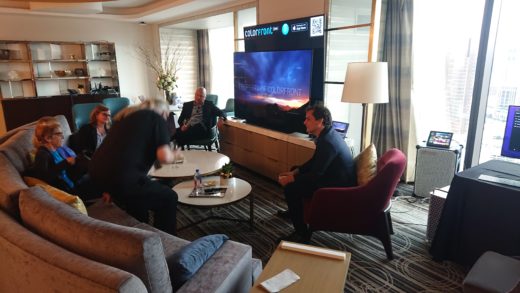
It’s recently been felt to be a bad idea to have several members of different families sit in close proximity in a warm, enclosed space for day after day, which has made the usual process of colour grading difficult. As a result, at the height of the pandemic, various approaches to remote grading were thrown together, with the emphasis very much on “thrown.” One prominent member of a very selective cinematography society, who must unfortunately remain anonymous, found himself grading a nine-figure production on a system reliant on four ganged 4G data modems, with occasional breaks to pay for more and more bandwidth.
Remote grading, then, has not much to do with the sort of video conferencing with which many of us have become far too familiar, but it’s one of those concomitants of the pandemic that might actually have a useful long-term outcome. That’s the position taken, at least, by finishing specialists Colorfront, whose tools have become familiar parts of the finishing process for some of the world’s largest productions.
Formalising the process
With all that in mind, the company has formalised the process as a product simply called Colorfront Streaming Server, which is designed for a variety of situations where people need to watch a reasonably accurate preview of something at arm’s length. The word “reasonably” is carefully chosen here, with LG’s OLED TVs and various Apple products described as “near-reference” displays by the company; side by side comparison with actual reference displays tend to confirm this idea.
Particularly, the system relies on the ability of some recent devices to reliably report their display capabilities so that appropriate colour management can be used to create a display that’s as good as the available hardware is capable of providing. It sounds simple – it sounds like Zoom on steroids – but there are subtleties. For a start, latency is key; one-to-many streaming services such as Twitch often tolerate latencies in the tens of seconds, usually so they can buffer up enough material to ensure reliability in the case of flaky internet connections at various points.
Colorfront’s work already involves a lot of colour management, much of which will have been repurposed in the creation of the streaming server. Even so, the requirement for a properly colour managed system means that the company’s own player application is required. This a high bandwidth, ten-bit, fully colour managed configuration which required Colorfront to scratch build a complete server infrastructure. It’s not something we can watch in VLC.
Because Colorfront’s diet consists almost entirely of very high end projects which involve a lot of security and viewer-identification requirements, there’s quite a thick layer of security, too. The underlying video transport is SRT, which is more than sufficiently encrypted for the most demanding security situations, but there’s also a random key generation system, the option to add burn-ins, and various other attempts to ensure that only the right people get access to the next big-name comic book movie.
Remote grading gets tricky
This is one of those things that’s relatively straightforward in principle but gets sticky in the details. Colorfront has long been a maker of solutions to destickify those details, with vast capabilities around closing gaps in workflows, particularly when a high-end production needs to satisfy the steely-eyed QC people an equally high-end distributor.
Colorfront is a quiet but successful company, one that typically restricts its NAB presence to a hotel suite in which it demonstrates difficult things done well – not only remote grading but also get, measurement and automated transformations between wildly incompatible colourspaces and brightness encodings which work beautifully and, in the grand tradition of a SIGGRAPH presentation, compare almost imperceptibly to a ground truth in tests.
It’s easy, then, to justify Colorfront’s confidence in its new remote grading and previewing system, and if it can allow increasingly beleaguered directors of photography to take the more active role in grading that most of them want, it’s likely to do well.
